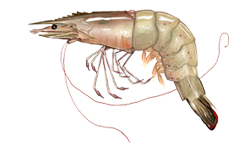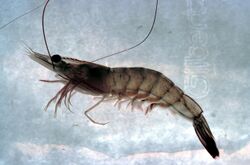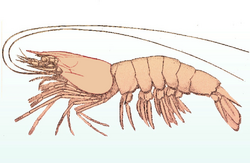Biology:Litopenaeus setiferus
| Litopenaeus setiferus | |
|---|---|

| |
| Scientific classification | |
| Domain: | Eukaryota |
| Kingdom: | Animalia |
| Phylum: | Arthropoda |
| Class: | Malacostraca |
| Order: | Decapoda |
| Suborder: | Dendrobranchiata |
| Family: | Penaeidae |
| Genus: | Litopenaeus |
| Species: | L. setiferus
|
| Binomial name | |
| Litopenaeus setiferus | |
| Synonyms | |
| |
Litopenaeus setiferus (also accepted: Penaeus setiferus,[1] and known by various common names including Atlantic white shrimp, white shrimp, gray shrimp, lake shrimp, green shrimp, green-tailed shrimp, blue-tailed shrimp, rainbow shrimp, Daytona shrimp, Mayport Shrimp, common shrimp, southern shrimp, and, in Mexico, camaron blanco) is a species of prawn found along the Atlantic coast of North America and in the Gulf of Mexico.[2] It was the subject of the earliest shrimp fishery in the United States.
Distribution
The range of L. setiferus extends from Fire Island, New York to Ciudad Campeche, Mexico.[2] It requires warm water, and is unable to survive below 3 °C (37 °F), with appreciable growth only occurring at temperatures over 20 °C (68 °F).[2]
Description
Litopenaeus setiferus may reach a total length (excluding antennae) of 197 millimetres (7.8 in), with females being larger than males.[2] The antennae may be up to three times the length of the body, which is bluish white with a tinge of pink on the sides, and black spots.[3] The pleopods are often redder, and the uropods and telson are green.[3] The rostrum is long and thin, with 5–11 teeth on the upper edge and 2 on the lower edge, and continues along the carapace as a dorsal carina (ridge).[3] Deep grooves alongside the carine separate the related species Farfantepenaeus aztecus ("brown shrimp") and Farfantepenaeus duorarum ("pink shrimp") from L. setiferus.[2][3]
Ecology
Litopenaeus setiferus lives in estuaries and from the littoral zone to water with a depth of 100 feet (30 m) in the Atlantic, or up to 260 feet (79 m) in the Gulf of Mexico.[3] Litopenaeus setiferus is an omnivore; in Lake Pontchartrain, it feeds chiefly on the seagrass Vallisneria americana and detritus.[4] Many aquatic animals feed on L. setiferus, including fish such as red drum (Sciaenops ocellatus) and turtles such as the loggerhead sea turtle (Caretta caretta).[4]
Life cycle
Spawning in L. setiferus occurs while the water is warm, between the increase in water temperatures in the spring and the sudden decline in temperature in the fall.[2] It generally occurs within 9 km (5.6 mi) of the shoreline, in water less than 9 metres (30 ft) deep in the Atlantic, or 8–31 metres (26–102 ft) deep in the Gulf of Mexico.[2] Males attach a spermatophore to the females, which is then used to fertilize the eggs as they are released.[2] Each female releases 500,000–1,000,000 purplish eggs, each 0.2–0.3 mm (0.008–0.012 in) across, which sink to the bottom of the water column.[2]
After 10–12 hours, the eggs hatch into nauplius larvae, which are 0.3 mm (0.012 in) long, planktonic and unable to feed.[2] They molt five times to reach the protozoa stage, 1 mm (0.039 in) long. These grow to 2.5 mm (0.098 in) long over two molts, before passing through three molts as a mysis larva.[2] About 15–20 days after hatching, the animals reaches the postlarva stage; in the second postlarval stage, at a length of 7 mm (0.28 in), they begin to enter estuaries and drop down to the substrate.[2]
Spring rains flush the shrimp out into the ocean. In the Eastern United States, shrimp then migrate south towards warmer waters.[5]
Fishery
Subsistence fishing for prawns was carried out by Native Americans along the Atlantic coast.[6] This knowledge was passed on to European settlers,[6] and Litopenaeus setiferus became the subject of the earliest shrimp fishery in the United States, with commercial fishery for L. setiferus starting as early as 1709.[2]
The harvesting for L. setiferus began in the 1950s and since that time is collected monthly throughout Gulf of Mexico.[7]
Notes
- ↑ "WoRMS". http://www.marinespecies.org/aphia.php?p=taxdetails&id=762818. Retrieved 2020-02-13.
- ↑ 2.00 2.01 2.02 2.03 2.04 2.05 2.06 2.07 2.08 2.09 2.10 2.11 2.12 Robert J. Muncy (1984). White shrimp. Species profiles: life histories and environmental requirements of coastal fishes and invertebrates (South Atlantic). United States Fish and Wildlife Service. pp. 1–19. FWS/OBS-82/11.27. http://www.nwrc.usgs.gov/wdb/pub/species_profiles/82_11-027.pdf.
- ↑ 3.0 3.1 3.2 3.3 3.4 "Litopenaeus setiferus". Field Guide to the Indian River Lagoon. Smithsonian Marine Station at Fort Pierce. https://www.sms.si.edu/irlspec/Penaeu_setife.htm. Retrieved October 2, 2018.
- ↑ 4.0 4.1 Christopher D. Davis (July 2009). "A Generalized Food Web for Lake Pontchartrain in Southeastern Louisiana". Lake Pontchartrain Basin Foundation. https://studylib.net/doc/8220586/a-generalized-food-web-for-lake-pontchartrain-in-southeas.... Retrieved October 2, 2018.
- ↑ Reed, Matt (December 22, 2011). "Will U.S. fish limits deplete Canaveral's fleet". Florida Today (Melbourne, Florida): pp. 10A.
- ↑ 6.0 6.1 G. Riekerk. "Commercial Fisheries: Shrimp". Characterization of the Ashepoo-Combahee-Edisto (ACE) Basin, South Carolina. National Oceanic and Atmospheric Administration. http://nerrs.noaa.gov/Doc/SiteProfile/ACEBasin/html/resource/commfish/cfshmpfh.htm. Retrieved May 11, 2011.
- ↑ Rick A. Hart and James M. Nance. "Three Decades of U.S. Gulf of Mexico White Shrimp, Litopenaeus setiferus, Commercial Catch Statistics". National Oceanic and Atmospheric Administration. https://www.galvestonlab.sefsc.noaa.gov/publications/pdf/946.pdf. Retrieved October 2, 2018.
Other references
- White shrimp NOAA FishWatch. Retrieved 4 November 2012.
Wikidata ☰ Q5221424 entry
 |



